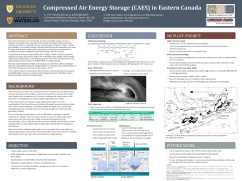Energy Storage in Salt Caverns
Global Energy Goals
There is a rising global awareness of the need to reduce our carbon footprint. The United Nations Sustainable Development Goals call for countries to take urgent action to resist climate change (Goal 13); reducing our reliance on traditional, high-carbon energy sources and ensuring access to susainable, affordable clean energy (Goal 7) is critical to achieving this.
One factor limiting the increased use of renewable energy is the availability of energy produced this way; energy may not always be available during times of peak demand. With an increasing focus on a decarbonized future, energy storage is a crucial issue for grid management.
Energy storage is required to
- Combat peak energy demands
- Create a stable energy input, due to the instability of renewables
i.e. wind power - Storage technologies that provide energy within short time frames – seconds to days – are necessary
Compressed Air Energy Storage
Compressed Air Energy Storage (CAES) is an adaptable energy storage system, achieved by the following:
| Salt Cavern Storage | 50-1000 MW |
| Permeable Aquifer Storage | 10-200 MW |
| Large-diameter Steel Cased Wellbore Array | 2-40 MW |
| Surface Pressure Vessels | 0.1-5 MW |
| Underwater Balloons | 0.5-5 MW |
CAES provides storage of excess baseload and renewable energy inputs over timeframes of minutes to days. It also delivers highly fuel efficient partial loading and rapid response capabilities allowing for low-carbon energy demand balancing on the grid.
CAES in Salt Caverns
The best medium for CAES is salt.
- Possible to create caverns that are large enough, stable enough, and with wide pressure limits to allow highly efficient use of the storage capacity
- Compared to porous medium, salt caverns are superior for compressed air storage
- No deliverability issues
- Rapid recharge/discharge can take place
CAES In Nova Scotia
Canada’s Maritime provinces are exceptionally well-positioned to eliminate carbon-based power, on a short time scale.
- Excellent conditions for wind and tidal energy generation
- Energy storage is necessary to transform intermittent and low-quality power from renewables into power that can be fed into grids with on-demand deliverability
- Strong potential for energy storage in Atlantic Canada, as ideal geological and geographical conditions exist – salt caverns
Northeast Nova Scotia
Vertical caverns with the potential to reach 800,000m3 i.e. Malagash Anticline
The caverns can be spaced at 300 to 400 m centers
The Nova Scotia salt diapir size indicates it is feasible to have many caverns

